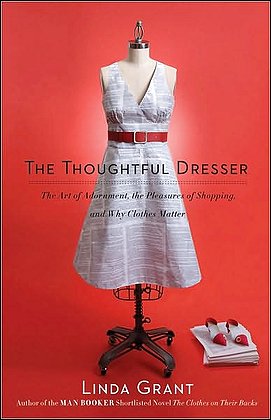 The Thoughtful Dresser is a book that I wanted to like. It’s one of those themes — women and their clothes — that can be deeply interesting because there is so much negativity attached to it. I also have strong feelings about the topic and I was hoping to find more thoughts in the line with my own.
The Thoughtful Dresser is a book that I wanted to like. It’s one of those themes — women and their clothes — that can be deeply interesting because there is so much negativity attached to it. I also have strong feelings about the topic and I was hoping to find more thoughts in the line with my own.
It started like that. The book seemed to have had many good intentions in the beginning, but somewhere it failed to deliver any sort of deep message beyond: beautiful clothes are a pleasure that we should not deny ourselves. Which is not a bad message in itself, but which, at the same time, is not enough. There are pleasures and there are pleasures, and wearing beautiful clothes is among those pleasures that we are not sure what to do with, like eating and sleeping. It’s among those pleasures that we blame all our misfortunes on and not among the pleasures that we keep in higher regard, like watching team sports. I think that making clothes and putting together outfits the reflect a style and various moods, are forms of art, an art with immediate and strong impact on various psychological levels. But this is not the direction of this book.
All the time reading the book I felt excitement at the beginning of the chapter, and as the reading continued I was let down, time and time again. No, this is not an enlightened book that will leave you feeling entitled to own and wear that beautiful dress while still viewing yourself as an intelligent and valuable individual in the world. If that is what you’re looking for, then you need to keep looking. This book only reinforces old-time tales of women’s imperfect bodies that need cover and designer clothes that are an ultimate cover which sadistically will never fit our bodies.
A large part of the book is dedicated to the story of Catherine Hill, a holocaust survivor who became successful in the fashion industry owning several stores and having known well many big names in the high fashion world. Sure, I told myself, now the revelations will come, from the experience of this extraordinary woman who had been through the unimaginable and turned to clothes to make her life beautiful again. Unfortunately, even that line of the story fell flat. We are left with an image of Catherine Hill wanting to cover women’s imperfect bodies, because the cover had been denied to them in the camps at different times, and that had been unbearable to them. As much as this might be a powerful message, I do not want to be left with the idea that I need to cover my imperfect body.
Maybe I found the book distressing also because the message was often contradictory. For example, on one page we are told that designers don’t care about us, the women who would buy and wear their clothes. They only care about themselves and what’s in their minds. On the the next page we are told how lusting for designer shoes is just normal and OK, and going for glamor is all that is left for a woman over 40 (one definition of glamor being the designer label).
The parts that I did like were those few incursions into fashion history, Christian Dior’s thoughts on the New Look and Coco Chanel’s preference for simplicity and cheaper, comfortable fabrics (jersey, yes!). But I am sure there are many other books that discuss these issues to more depth.
The book could also have used a better editor: many ideas were repeated several times throughout, for example how you can tell the age of a photograph by looking at the clothes the people in it are wearing, or how the author inherited her thick ankles and thick wrists from her peasant Russian and Polish ancestors. Throughout the book you can feel the author’s sense of displeasure with herself: her body, her aging, her inability to wear designer shoes. Don’t we have enough magazines, commercials for cosmetics and surgery that show us how much our bodies are lacking? I personally do not feel any need to also read books that reinforce these ideas.
One question this book did leave me with: who is the thoughtful dresser? Certainly, it is not the reader, because the readers do not get any insight or advice into how to put more thought into their dressing. No. The thoughtful dresser can only be the writer herself, who put some thought into writing this book. Unfortunately, the book’s relevance does not extend beyond her person either.

